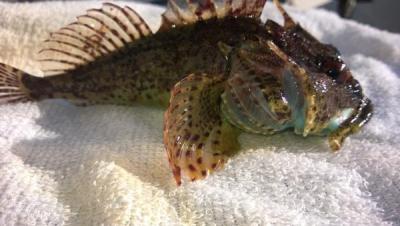Scorpion Fish
Also know as: Bullhead, Short-spined Sea Scorpion, Bull-Rout, Rockfish, Clobberhead, Father-Lasher, Scorpionfish, Rock Sculpin, Short-horned Sculpin, Granny Fish
- Size: up to 18 inches in length and 2-3lbs, but most much smaller than this
- UK minimum size: 8ins/20cm
- UK shore caught record: 2lb 7oz
- Feeds on: Anything it can find including fish the same size as itself.
- Description: Small squat fish with very large head and mouth relative to its body size. Rest of scaleless body is thin and tapering. Two spiky dorsal fins with no gap between them. Spines on gill covers and head and small spikes running down the lateral line. Usually mottled brown/green in colour, but colour can vary greatly between fish. Belly is usually red in males and orange in females.
- The main species of sea scorpion found in UK waters is commonly called a bullhead or short-spined sea scorpion (Myoxocephalus scorpius). This species can be found in rocky ground, but also over sandy and muddy seabeds in depths down to fifty metres or so. It is an aggressive predator which feeds on fish, prawns, crustaceans or any other small marine animals which pass. It does not hunt prey as such but feeds as an ambush predator, waiting for prey to come past and then snapping at them. Its large mouth and fast digestive system (it can digest its own body weight in around an hour) allows it to feed on fish the same size as itself.
- Second Species of Sea Scorpion in UK Waters
The other species of sea scorpion found in the UK is the long-spined sea scorpion (Taurulus bubalis). This species looks very similar to its bigger cousin but only grows to a maximum length of seven inches. It has two longer spines on each gill cover whereas Myoxocephalus scorpius has a higher number of shorter spines. A further difference is that the short spined has barbels on the edge of its mouth and these are absent on the long-spined. Angling for Sea Scorpion and Value to Humans
Anglers do not target sea scorpion as such but they are often caught on bait meant for other species. They can take surprisingly large baits, including big squid and fish baits meant for cod! Sea scorpions are present in UK waters all year round but are caught slightly more often in summer when they come into shallower water and feed more actively. Smaller sea scorpions are often found trapped in rockpools by the outgoing tide. Like sharks, rays, mackerel and tuna the sea scorpion has no swim bladder and sinks as soon as it stops actively swimming. Due to their small size, unusual appearance and spines sea scorpions have absolutely no commercial value at all. They are, however, popular to keep in marine aquariums due to their striking appearance and aggressive behaviour when feeding.
- Description: Small squat fish with very large head and mouth relative to its body size. Rest of scaleless body is thin and tapering. Two spiky dorsal fins with no gap between them. Spines on gill covers and head and small spikes running down the lateral line. Usually mottled brown/green in colour, but colour can vary greatly between fish. Belly is usually red in males and orange in females.



Recommended Comments
There are no comments to display.